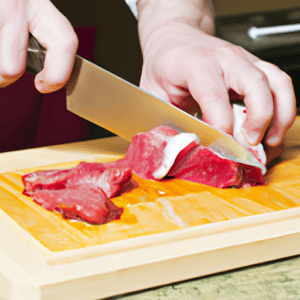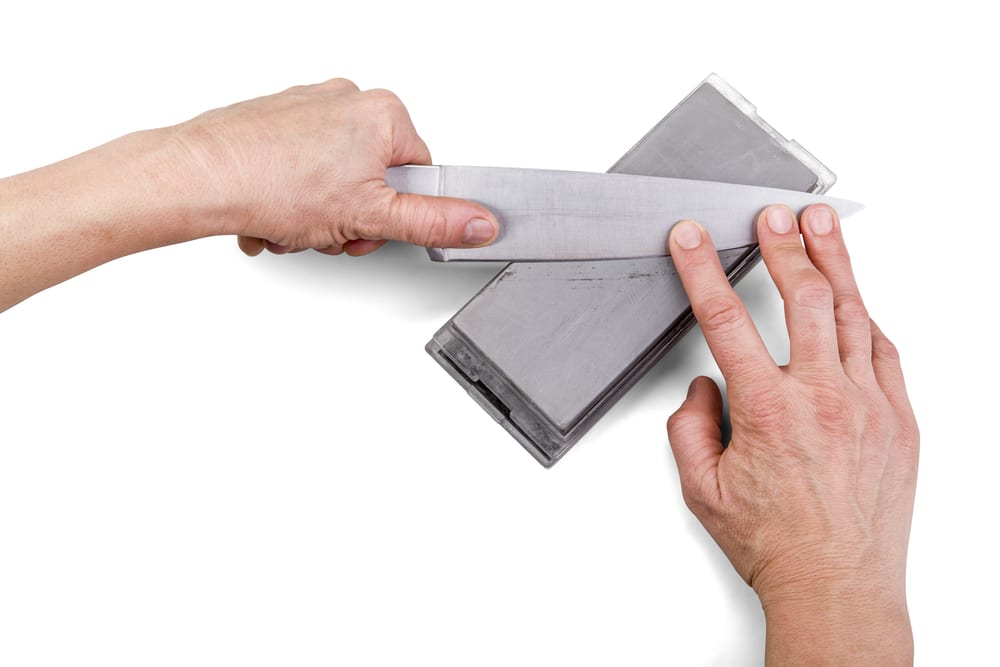Are you wondering how to sharpen kitchen knives?
The right set of knives is a vital part of your kitchen equipment. Although your kitchen knives might be razor-sharp when you first buy them, regular use and cleaning can gradually cause the edge or blade to go blunt. The good news is you can keep your knives as sharp as possible with a bit of maintenance.
Learning how to use the right tools for sharpening steel should ensure you keep your kitchen knives in excellent condition for the years to come. Whether you’re using a manual knife sharpener, an electric knife sharpener, or something else to enhance your blade edge, you’ll find yourself getting the hang of this technology in no time.
Today, we’re going to teach you everything you need to know about making the most of your knife blade and ensuring you always have a sharp knife available.
What Happens When You Sharpen Knives?

Using a knife sharpener, like a sharpening stone, a steel rod, or something similar, improves the edge of your knife by grinding away small amounts of steel. When you have a dull knife, this often means the very edge of the knife has worn away over time, leaving a blunter finish.
In general, the cutting edge of your standard kitchen knife will be a sharp “V” shape. If you look at a brand-new knife under a magnification lens while it still has its factory edge, you’d see this shape. Different knives have different angles connected to them, but the smaller the angle overall, the more likely you’ll end up with a dull blade.
After a while, the V shape, which keeps knives sharp, will grind away to more of a U shape. This will mean that you can’t cut through food as easily as you once did. The knife will naturally grow duller when placed in your knife blocks or used on a cutting board.
When there’s too much metal on the very edge of the knife, knife sharpeners cut this away to return the V angle.
Sharpening Steel vs Knife Sharpening
Crucially, honing steel is one of the most common options for sharpening a knife. Sharpening steels look similar to steel rods, and they often come as part of a knife kit if you buy a good quality collection. The metal wand has a coarse grit on the side, so when you run the side of the blade over the grit, it grinds at the edge of the knife.
Honing steels are good for helping a knife slice more effectively. However, it’s worth remembering that even the best knives will often need more than just sharpening steel to maintain excellent performance. If you cook every day, you can use your sharpening steel every time you wash your knife. However, you won’t fully sharpen the blade the same way you would when you use coarse stones or a whetstone.
Sharpening steel places the microscopic teeth in your knife back into alignment, giving you the feeling of a smoother, sharper knife.
How to Sharpen Your Knife
Outside of your honing steel, there are various tools you can use to improve the performance of your kitchen knives. The process of sharpening knives can be very straightforward with access to the right tools. For instance, you can create a sharp knife with electric knife sharpeners, or you can use a manual knife sharpening tool, like a whetstone, to manage the sharpening process. The best knife sharpeners will completely reform and enhance the edge of your knife.
The most common (although somewhat old-school) way to sharpen a knife securely is to use a whetstone. Some people use a leather strop, but professional chefs often prefer a whetstone. You can also buy these products for a relatively low cost, making them ideal for beginner chefs too.
Using a Whetstone
To use a whetstone:
- Place a piece of damp paper towel on a flat surface, and rest the whetstone on top of it to prevent it from moving when you’re sharpening your knives.
- Place the knife on the coarsest side of the stone at a 15-to-20-degree angle. The tip of the knife should always be pointing away from you.
- Drag the knife over the whetstone in a circular, sweeping motion to keep the angle as consistent as possible. You can do this a few times before flipping to the other side.
Your dull knife should have a much sharper edge by the time you’re done. You can use the paper test, which involves slicing through a piece of paper with your knife and seeing how sharp it is before placing the knife back into the kitchen drawer.
Using Electric Sharpeners
Many people love the relaxing sensation when they sharpen knives with a traditional whetstone. However, you can save a lot of time and effort when you sharpen kitchen knives with an electric sharpener instead. You can avoid the stress of having to look for fine grit or a finer stone every time you get another cutting-edge knife.
Western-style knives often perform quite well when sharpened with an electrical product. Most electric knife sharpeners will include a honing and sharpening slot. When you drag the knife through the slot, you get a sharp edge as a result. The electric knife sharpener often includes a set of grinding wheels, spinning within the slots for your knife to help polish your knife at the right angle automatically.
You’ll need to follow the instructions provided when you begin the sharpening process carefully. It is possible to sharpen your knives too much if you’re not careful. Failing to follow the manufacturer’s instructions could damage your knife rather than make it super sharp. It could also increase your chances of injury.,
When you place your knife into the V-shaped chamber, don’t push down to try and sharpen your knives faster. Avoid pausing the stroke on the knife as they pull through the sharpener slot, too – this can cause over-sharpening and lead to uneven edges. Although an electric knife sharpener is a faster way to remove metal from the edge of your knife, it does take some getting used to. You’ll also need to pay a little more to sharpen your knives this way.
Can You Get a Knife Professionally Sharpened?
If you have a high-quality and expensive knife in your possession and you’re not confident with your knife sharpening techniques, you can request assistance from a professional.
There are many premium knife brands that can help you improve your chances of a sharper, more professional knife if you need some guidance. However, these companies can charge quite a lot for professional sharpening, so you’ll need to make sure you care for your knife to reduce the amount of sharpening you need to do.
Here are some tips to guide you through the sharpening process:
- Always make sure you sharpen each side of the blade the same amount. This will ensure that you have the right sharpness level, no matter how you use your knife. Sharpening processes will usually only take a few seconds, so don’t go over the top.
- Know your angles. Usually, sharpening the blade at a 20-degree angle or 15-degree angle is the best option. This angle makes the blade sharp enough to deliver an excellent clean cut while still ensuring you have a safe knife. The lower the angle, the sharper your blade will be.
- Use the coarse side of the whetstone, and always keep the sharp blade edge facing away from you when you’re sharpening with a manual device. Use your dominant hand to ensure you can control the movement carefully. Your dominant hand will make it easier to go through the sharpening process as quickly and safely as possible.
- Follow the manufacturer’s instructions when sharpening with an electric blade sharpener. An electric sharpening device may be much easier and quicker to use, but it’s also easier to damage your knife if you’re not careful. Make sure you don’t sharpen for too long, or you will risk harming your blade.
- Practice your techniques carefully. Take your time when using your blade-sharpening devices. It would help if you never attempted to rush through the process of sharpening your blade, as this increases the risk of injury and damage to the product.
How Often Should You Sharpen a Blade?
Generally, you should be able to tell when your blade needs to be sharpened based on its ability to cut through foods as normal. If you notice your blade is struggling with simple tasks, this usually indicates you’ll need to work on it. Ideally, you’ll use your sharpening or honing steel more regularly than the full sharpening system.
To ensure you’re protecting your knives and keeping the blade in excellent condition for as long as possible, remember to store your knives correctly. Placing your knife in a block is likely to cause the blade to get duller a little faster because you’re rubbing the edge of the blade against the wood or plastic every time you pull them out or place them in the block.
If you have a very high-quality blade you want to protect, it’s best to get a knife guard that you can get individually or as a set. This will give you a safe and reliable place where you can store your knives when you’re not using them.
For longevity purposes, it’s also a good idea to immediately hone the steel of your blade after you’re done washing the knife. Follow the instructions provided when cleaning the blade, and only use the dishwasher if you know it’s safe.
If you have already sharpened your knives several times and they are still dull, it may be time to let go of them finally. However, you mustn’t just throw them away directly, as they can be dangerous. It is essential that you know how to dispose of kitchen knives properly.
Sharpening Knives
Now you know how to sharpen kitchen knives, you won’t feel the need to go out and buy new knives every time your become dull.
Make sure you follow the instructions and listen to your knives, and you will get to grips with them in no time!
Do you have other tips for sharpening knives effectively? How do you sharpen your knives? We’d love to hear all of your ideas! Let us know in the comments below!

